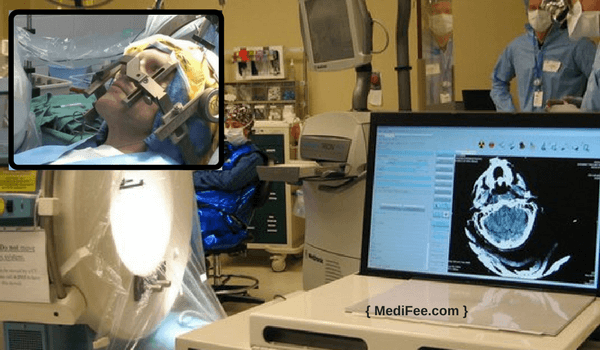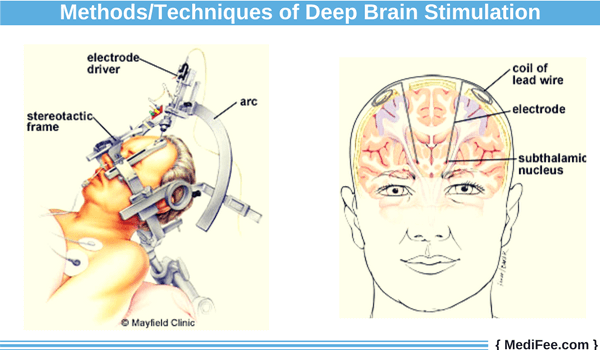Deep Brain Stimulation
Listed below is the step by step procedure of deep brain stimulation:
- What is Deep Brain Stimulation?
- Why is Deep Brain Stimulation Required?
- Pre-operative Preparation
- Day Before Surgery
- Procedure Day
- Methods/Techniques of Deep Brain Stimulation
- Post Procedure
- Risks and Complications
- FAQs
What is Deep Brain Stimulation ?
Parkinson's is a very serious neurological disorder most likely to happen in elderly people. Deep brain stimulation is a surgical procedure that treats symptoms of the same. Parkinsonism is not the only condition which can be treated with deep brain stimulation. There are other conditions like cerebellar tremors, dyskiniesia and other debilitating neurological disorders that can be cured by deep brain stimulation. It is important to remember that deep brain stimulation is not a cure for Parkinson's, but it is simply a treatment to give better sense of control to the patient suffering from this disorder.

Why is Deep Brain Stimulation Required?
- Motor disability: If you are suffering from Parkinson's, then it is highly possible that you do have motor disabilities that inhibit your physical movements and coordination despite taking regular prescription medication. In such cases, surgery for the same ie. deep brain stimulation is required.
- Dystonia: It is a movement disorder that affects the entire body or even single muscles. When the dystonia is limited to a single body part like eye, neck, hand and voice, it is termed as focal dystonia. Painful spasms are caused to the person because of wrong signals reaching the brain.
- Essential Tremors: Essential tremors are a type of neurological disorder. It can happen to people of any age. This disorder is characterized by rhythmic trembling. Patients suffering from essential tremors is not able to write in a proper and legible manner. They are also unable to talk or eat normally without spilling the contents on their plates. Deep brain stimulation is a surgical option when therapeutic options have been explored and medications too haven't worked any well.
- Obsessive Compulsive Disorder: It is an anxiety related condition characterized by obsessive and repetitive thoughts of doing one particular thing over and over again. Also, deep brain stimulation is recommended for patients suffering from OCD for a period of 5 years and also have been on anti-psychotics.
Pre-operative Preparations
A team of specialist doctors that include a neurologist, a neurosurgeon and a neuropsychologist, are present to first assess your condition to determine if surgery is really the last option. Your memory retention, your thought process, and the general health status along with the current medications are aspects taken into consideration. Your movements will be recorded while walking, sitting down and rising from a chair both while on medication and also when you haven't taken those medicines. Your symptoms and abilities are then measured using the Unified Parkinson Disease Rating Scale (UPDRS). Evaluation is then done looking at the videos of patients by team of doctors.
Further, the doctor will order few tests like blood tests, electrocardiogram, and an MRI scan of brain in preoperative period of this procedure. You will be asked to discontinue any blood thinning medication like aspirin, motrin in the week before surgery. The doctor also needs to be informed about your health history and also if you have undergone any surgeries previously.
Day Before Surgery
The patient needs to fill up a consent form prior to surgery. On the day before surgery, the head of patient is shaved off as preparation. An anesthesiologist also tests his/her tolerance or allergies to anesthesia. And then accordingly, the most appropriate anesthetic agent for use on procedure day is decided. The patients can discuss their queries with the surgeon and also get their doubts solved. Also, consuming any food or fluid post midnight is not allowed. Also, the medication the patient was on for Parkinson's is also stopped on the day before surgery when they get admitted to hospital.
Procedure Day
- Clothing: Have a shower and use an antibacterial soap. Remember to dress in clean and loose fitted clothes that are not too hard on the body.
- Shoes: Also, do not wear high-heeled shoes at any cost. It is always best to wear flat-heeled buckled shoes because of the comfort level they offer to the wearer.
- Water: If you have to take regular medications for any other medical condition, then on the morning of surgery, do so with only small sips of water.
- Remove every accessory: Remove every ounce of make-up, accessories like hairpins, nail polishes, contact lenses, body piercings etc.
- from your body.
- List of medicines: Carry a list of prescription medications you usually take written along with dosages as prescribed.
- Allergies: Also make a list of medicines and foods your body is allergic to.
- Intravenous line: Patient will be hooked to an intravenous line so that liquids and medicines could be injected inside the body externally.
- Vital signs: Vital signs like blood pressure, pulse rate and body temperature are also checked before procedure commences.
- Sedation: Mild sedatives are given to the patient to ensure he/she does not experience any discomfort at all.
Methods/Techniques of Deep Brain Stimulation
A stereotactic frame which is the shape of a ring fitted on the head will be placed at points on the skull after local anesthesia is given.
The patient will be awake during the surgery as the operation would be done under local anesthesia. A hole is drilled on the top of patient's skull for initiating deep brain stimulation. The local anesthetic acts as a agent to remove sensation out of brain and bones and hence it becomes a painless procedure.
Small electrodes are then inserted into the brain to perform its mapping for studying specific regions in the brain. This process is known as known as micro-electrode recordings. Electrodes are placed based on findings of an MRI/CT scan. The precise angle is decided and electrode inserted in brain. Once the correct place is found, a low voltage current is passed that helps the surgeon know the side-effects as well as scope of improvement that can be achieved on patient's end. This is the stage where patient cooperation is very useful. After this step, patients will experience pain relief only if the correct site is targeted.

Once adequate confirmation is obtained by the surgical team, permanent deep brain stimulation lead is implanted under fluoroscopy guidance. The brain is stimulated to detect any abnormalities. Once the surgeons are satisfied about the electrode placement, the incision site is covered up with a cap and then stitched up. Lead wires are left inside skull for attaching to the stimulator. In the next step, general anesthesia is given. For accessing the lead wires placed in scalp, the older incision is re-opened. Neurostimulator is fitted under the skin in collarbone. You will be called to the hospital again in a period of 10 days. The stimulator is programmed and medication is adjusted accordingly. The programming is done every 3 weeks.
Post Procedure
- Post the operation, the medical team will help you to move from the bed to the washroom.
- Post deep brain stimulation, you may feel extremely disconcerted and blank. Do not panic, this feeling will subside in a couple of weeks.
- You will also get postoperative instructions from the medical team, to be practiced in recovery period. Most patients are allowed to go home the same day.
- The medical team trains you to use the deep brain stimulation system which remains "ON" continuously and is controlled by hand held device.
Dos and Don'ts after Deep Brain Stimulation
- Stitches: The stitches placed to seal the wound are removed in seven to 10 days after surgery.
- Band-aid: Each of the pin sites should be kept covered with band-aids until they are dry. These should be changed every day as necessary.
- Medications: You should continue taking medications for the condition you underwent as prescribed or as per dosage you followed in pre surgery period.
- Mild shampoo: You may use a mild shampoo for washing your hair the day after your stitches are removed by doctor.
- Scratch: The wound area should not be rubbed or scratched.
- Diet: Make sure you raise your intake of fluid and food gradually. This is important to keep you energized and also to prevent constipation caused because of medicines.
- Contact your doctor: Alert your doctor if you notice symptoms like shifting vision, incision bleeding, sharp headaches, fever etc.
Risks and Complications
- Stroke: The microelectrodes that are placed in the brain for finding the appropriate nerves can cause punctures in the blood vessels in there, triggering strokes. This in turn leads to eyesight issues, weakness and other nervous systemic disorders.
- Psychological disorders: Loss of interest in everyday activities, impaired judgment, depression, apathy and other such psychological disorders etc. are commonplace. Mood swings are also experienced by patients after undergoing deep brain stimulation.
- Cognitive problems: The patients who are undergoing deep brain stimulation can have problems with perception, memory retention, interactions with everyone and even while eating and swallowing. The patients who have symptoms like speech disorders may find that the symptoms become worsened.
- Infection: Risk of infection due to introduction of a foreign body always exists - be it in the internal structures of brain or skin.
- Battery issues: The battery used in device fitted may need to be replaced in 2-5 years. Further, the extension wire may break and then additional surgery maybe required.
FAQs
- Is the deep brain stimulation device that is implanted visible to others?
A. The incisions made during procedure are visible till they heal and the shaved part of head gets back hair. However, most men and women are able to hide the operated area so as not to make it look out of place.
- Where would you put the deep brain stimulation stimulator if I already have a pacemaker?
A. The pacemaker during its implant surgery is usually placed right under the collarbone on the left side of chest; whereas, the deep brain stimulation device is fitted in the right part of the chest.
- What does deep brain stimulation feel like when the device is on?
A. Some people may feel a short tingling sensation after the device is activated. You need to contact the doctor if you feel like shocks are passing through your body.
- Is the device implant a permanent procedure?
A. No, it is not a permanent procedure, it is in fact a reversible one. The stimulation can also be adjusted according to what symptoms you experience. Device removal is also possible.

